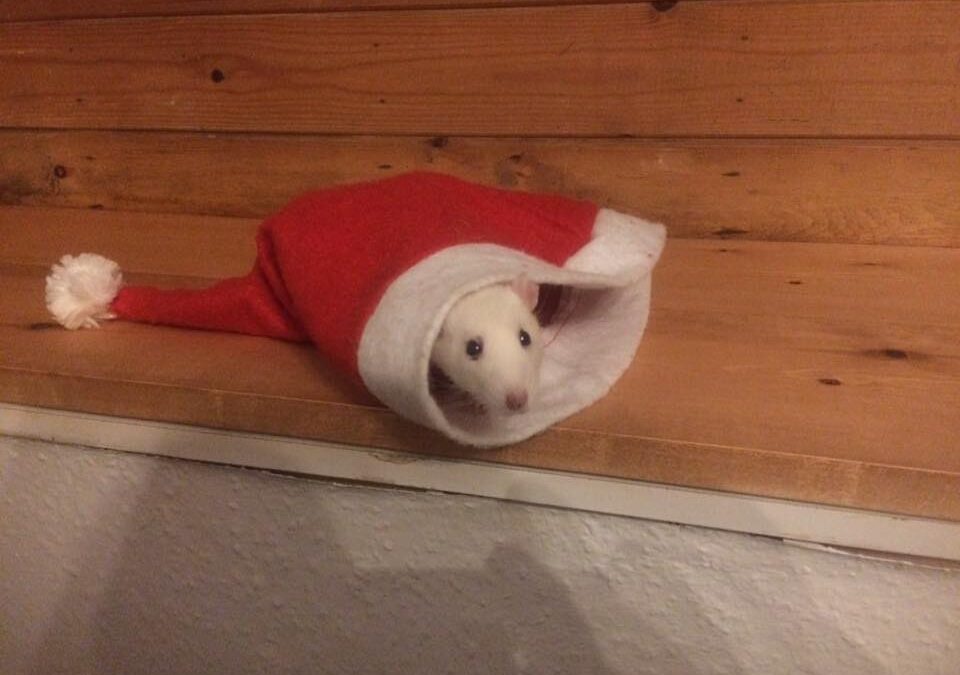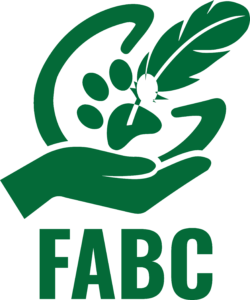
Merry Covid Christmas
HELPING PETS COPE WITH CHRISTMAS IN A PANDEMIC YEAR – THE TWELVE WELFARE TIPS FOR CHRISTMAS.
None of us know what Christmas will bring this year but vets can advise owners on the best way to avoid some predictable problems for animals over the festive period.
ONE- LOCKDOWN PETS
Many puppies and kittens have been acquired since the beginning of the pandemic. A lot of these will have had limited experience of visitors coming to the house, and some won’t have been exposed to many unfamiliar people outside due to social distancing. Since young animals learn to accept novel stimuli (including people) most easily during the ‘sensitive’ part of their development which lasts from approximately 4 to 13 weeks of age in puppies and from 2 to 7 weeks in cats, many lockdown puppies and kittens will have missed this window of opportunity in which to learn that unfamiliar people, animals, sounds, novel objects etc. do not pose a threat. They are likely to be at increased risk of being fearful of anything or anyone new they encounter.
Similarly, many people have taken on rescue animals since lockdown restrictions began in March. Some of these are ex-street dogs who have been transported from Eastern Europe, many of whom will have found the adjustment to living in a home in close proximity to people difficult and stressful. Whilst they may have started to habituate to their new environment and be more comfortable with family members, there is a high likelihood that they will feel threatened by the appearance of visitors.
TWO – CHRISTMAS GATHERINGS
Whether or not the Covid restrictions are fully lifted at Christmas, there is likely to be more social interaction between family and friends over the holiday period than these lockdown animals are used to. Lockdown puppies, kittens and rescue animals who show signs of fearfulness towards new people will need to be sensitively introduced to other people eventually, but the festive season is not the time to do it!
THREE – BE PREPARED
Owners should be advised to prepare in advance, to help their pets get through Christmas with as little stress as possible. More established pets will benefit from protection against stressful situations as well as new animals. In the weeks leading up to Christmas, owners can prepare a safe location for their pets that is in a room distant from the area where any visitors are going to be entertained, and encourage them to use this safe haven.
Puppies and adult dogs can be provided with a dog bed or covered crate with the door removed or left open – this should contain comfortable bedding and toys and they can be encouraged to spend time there by putting treats and chews inside; the owners should also sit near the crate when the puppy or dog is sleepy to encourage them to relax there and develop a positive association with the bed or crate.
A safe room for cats should contain food, water, litter trays and resting places. Cats feel safer if they can access an elevated position. If they don’t already have one, providing adult cats with a route to somewhere high and allowing them to get used to this in the weeks before Christmas will help them to feel secure when there are strangers in the house. Ideas include the tops of wardrobes or cupboards (with comfortable bedding), on a cat shelf with a box shelter to hide in, or a tall cat tree.
Young kittens can be accustomed to spending time in an enclosed pen by putting toys and food inside and the owner staying nearby until they are content to relax there when alone. Alternatively they can be encouraged to spend time in a small bedroom where there are no hazards such as high furniture or bunk beds that they could fall off when not being supervised. For timid, fearful kittens, the provision of cardboard box refuges could help them to feel secure.

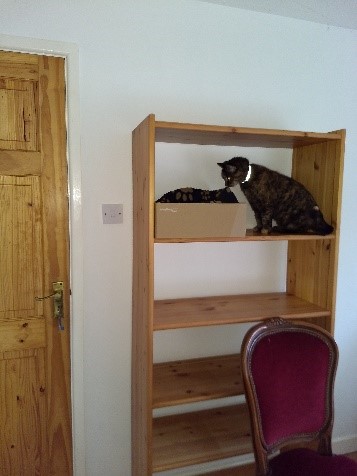
FOUR – BEING ALONE
Pets acquired in lockdown may have never learned how to cope with being alone if their owners have been present all the time. Prior to Christmas these owners should start to habituate them to short separations, ideally when they are relaxed or engaged in something enjoyable such as chewing. For pets that normally follow the owners closely whenever they move, it is a good idea to install a baby gate between two rooms that the dog normally spends time in – owners can then get them used to periods on the other side of the gate, but still in view, as the first step towards independence.
Even pets who formerly coped with being left alone may struggle with it if their owners have been constantly present over the last few months. All such owners should arrange short absences to test how their animals deal with it. Where possible, they should record their behaviour. If they don’t have a suitable camera, a propped-up mobile phone can record for a few minutes after owners have left.
If it is apparent that pets are anxious about being alone, owners should make their Christmas plans accordingly. Ideally pets who are fearful of unfamiliar people as well as being anxious about being left should not be taken to other people’s homes and even in their own home will need a family member to stay with them in their safe area.
FIVE – ARRIVAL OF VISITORS
Animals who are known to be fearful of unfamiliar people should be encouraged into their safe area prior to the arrival of visitors. If visitors might want to meet a new puppy or kitten, they should be informed in advance that it will not be possible for them to interact with the young animal for long, and invited to get to know them in a controlled way after the Christmas period.
SIX – CHRISTMAS PREPARATIONS
Even without visitors, Christmas can be a stressful time for many pets. Putting up Christmas trees and other decorations alters the appearance of the home, and sometimes involves moving furniture. The daily routine of owners may change and their behaviour become more erratic as they rush to get ready for Christmas Day. This can be stressful for animals who depend on the predictability of their environment for their emotional stability. The household may also be noisier than normal when children are becoming excited prior to and during Christmas day. The stress for the animals will be compounded if their adult owners become frazzled and stressed themselves! Encouraging pets to spend time in their safe area away from the hubbub will help to keep their stress levels down. Where possible their routine should also be kept as normal as possible, particularly timing of walks and feeding.
SEVEN – CHRISTMAS DECORATIONS
Christmas trees and decorations such as tinsel can also pose a danger to pets, particularly young ones. Kittens and young cats may find the Christmas tree irresistible to climb. They can injure themselves by falling, toppling the tree onto themselves, becoming caught in the threads holding baubles, as well as ingesting inappropriate objects from the tree. Puppies will often chew or ingest Christmas tree decorations and chocolates.
If owners are determined to have a tree when their pets are young, it is advisable to make it inaccessible to them but putting it up high or surrounding it with a protective pen such as an old playpen.


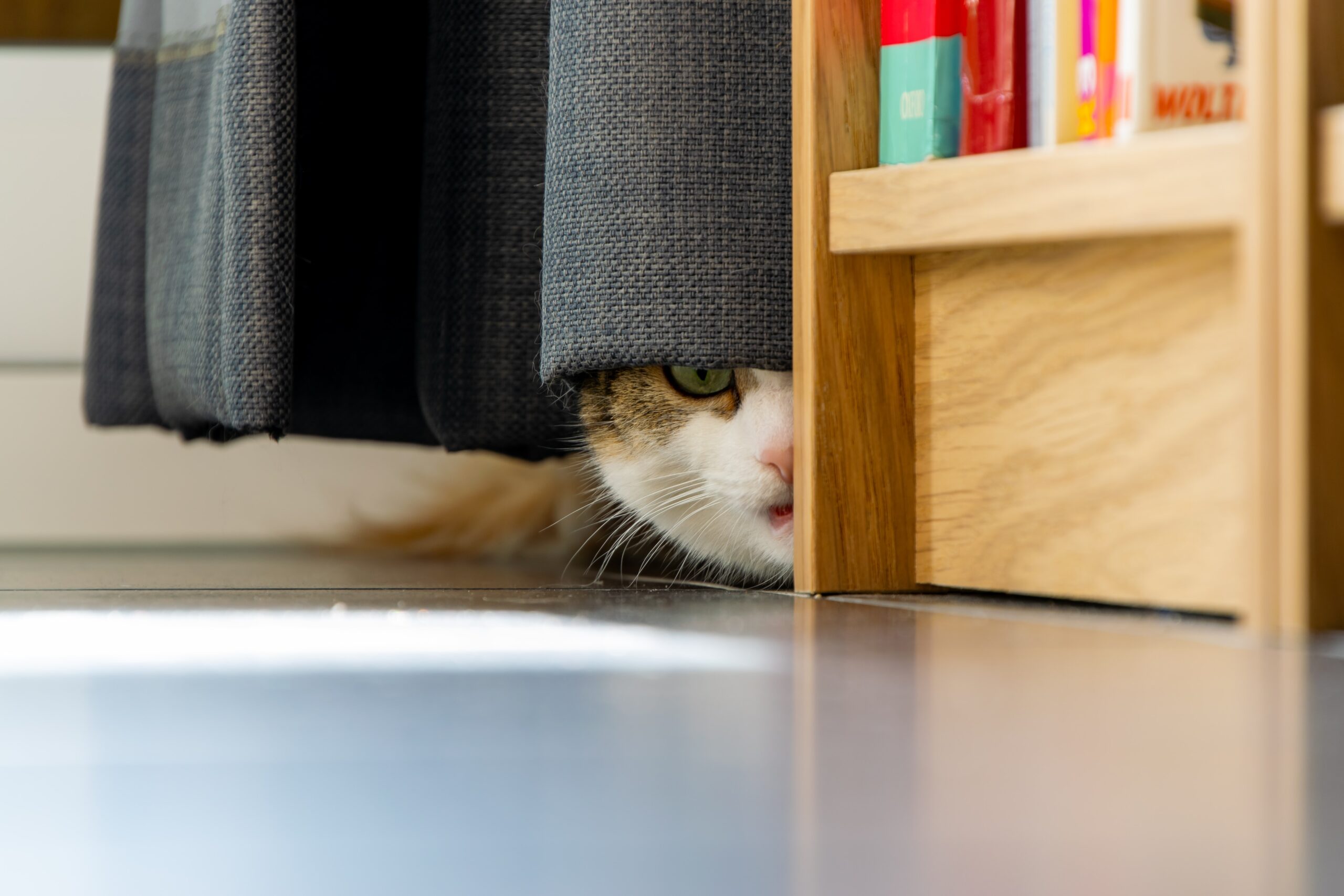
EIGHT – RECOGNISING FEAR
For all pets, it is important that owners can recognise signs of stress and fear so that they can take action to help them when necessary. Signs of fear can be obvious in some cases.
Puppies who are fearful may run away and hide under furniture or behind their owners’ legs. They may also lower their head and ears, tuck their tail under and freeze in position. Others bark at the objects of their fear with their tail tucked under.
Adolescent and adult dogs who are fearful may cower and withdraw, but some will resort to more overt defensive aggressive displays with hackles raised and weight forward.
Fearful cats and kittens will usually choose to run and hide. If unable to, they may show dilated pupils, flattened ears and raised hairs especially along the back and tail. When extremely scared they can hiss and strike at the objects of their fear
NINE – SUPERVISING VISITORS
Unfortunately, visitors often want to comfort fearful animals by approaching them and reaching a hand towards them while staring at them. This makes humans appear more threatening and increases the risk of the dogs biting and cats scratching. It is also very stressful for the animals involved, so owners should step in to politely prevent it.
Owners should consider the behavioural history of their pets and take precautions to avoid potential accidents involving people who are not familiar with them. For example, if a family is used to keeping all human food out of reach of their dog and avoiding taking any food items off him to prevent resource guarding, a well-meaning relative could be bitten if they tried to prevent the dog stealing someone’s turkey sandwich. Any dogs who show a tendency to guard food should be settled in a separate room while there is food around.
TEN – RECOGNISING SUBTLE SIGNS OF STRESS
The more subtle signs of stress are commonly missed by owners and other people. This can result in cats and dogs being subject to multiple unrecognised stressors, which accumulate by so-called ‘trigger stacking’ and can cause them to react strongly, and potentially aggressively, to the ‘last straw’ they are exposed to. Despite popular opinion, it can be very stressful for dogs to be hugged around their neck, particularly by children they don’t know, so it is extremely important to monitor interactions between children and dogs. Signs of stress that owners should be made aware of in dogs include: turning their head away, lifting one front paw with their weight backwards, yawning, licking their lips and noses, opening their eyes wide with a lot of the sclera visible (‘whale eye’), rolling on their back while remaining tense – this is a sign of anxiety and needs to be distinguished from a more relaxed rolling on the back in order to elicit belly rubbing. Very stressed dogs frequently also pace backwards and forwards, pant and salivate and often refuse treats or snatch at them. Signs of stress in cats include: yawning and licking their lips and noses, having sweaty paws, panting, showing heightened vigilance, and pretending to sleep while remaining vigilant. They may also show over- or under-grooming or house soiling.
Owners should watch out for signs of stress in their pets and remove them from stressful situations when necessary. They can be encouraged to go to their safe room and dogs can be taken outside for some calming activities – a walk somewhere quiet with plenty of sniffing opportunities or searching for scattered treats for example.
Owners of cats who have previously experienced stress-related medical problems or exhibited stress-related behaviours need to be especially careful to prevent additional stress at Christmas. Their cats can be encouraged to spend time in high vantage points and in their safe room and be allowed outside access whenever they want it (unless they are indoor cats). If one or more of the cats in a house has a tendency to urine spray when stressed, owners should avoid bringing too many novel objects into rooms the cats have access to. Nobody wants to find cat urine on the presents under the tree!
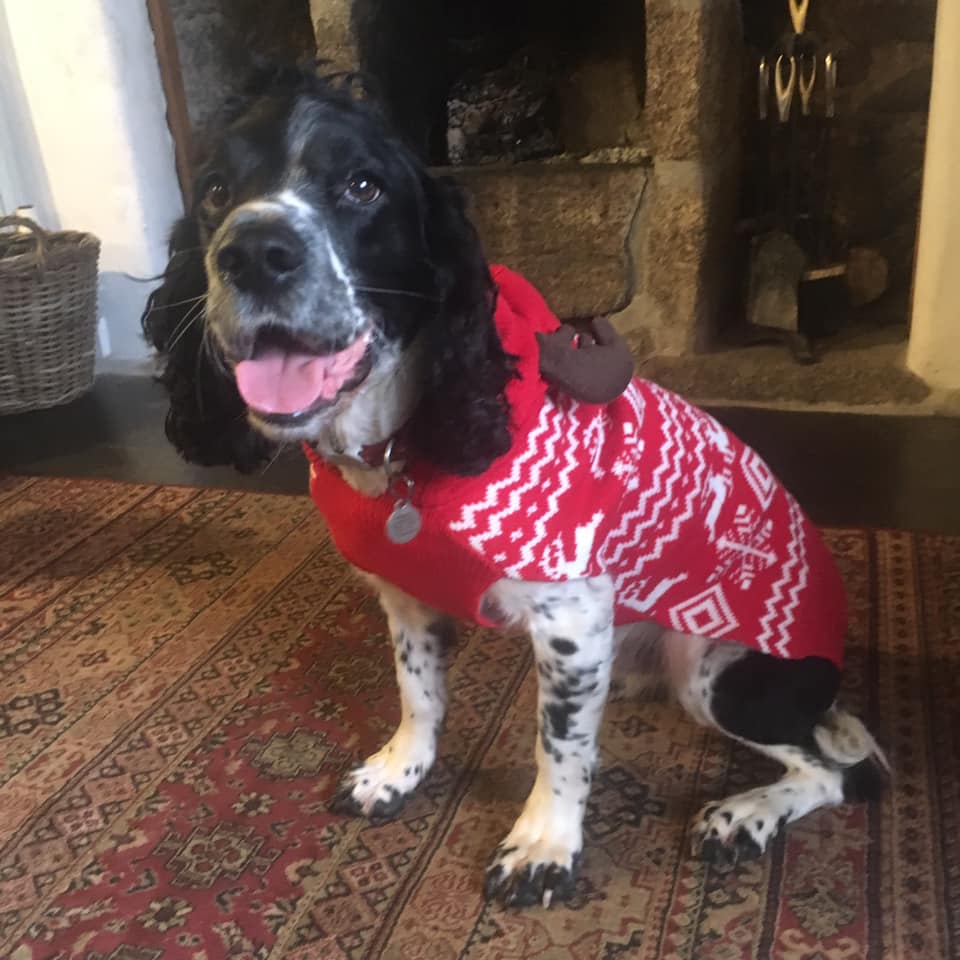
ELEVEN – CHRISTMAS OUTFITS
Although pets wearing Christmas costumes can appear endearing, it is important to ensure the experience is not stressful for them. After all, they don’t understand what is going on and they may already be in a heightened state of stress because of the other preparations they’ve been exposed to. Dogs and cats who have shown any anxiety about having harnesses or coats put on should definitely not be exposed to Christmas outfits – but confident dogs, especially those who regularly wear coats, jumpers or boots, may be quite relaxed about being dressed up, and enjoy the associated attention. The important thing is to monitor them to ensure that they are not feeling anxious or stressed.
TWELVE – AVOIDING OVER-AROUSAL and FRUSTRATION
Even animals who are confident and enjoy being at the centre of activity in the house can struggle on Christmas day if they don’t receive sufficient rest time. Over-tired puppies and young dogs can become over-aroused and start exhibiting unwanted behaviours such as jumping up and nipping at clothing and hands, especially when excited children are screaming and running around. They may also regress in their toilet training if over-stimulated by what’s happening in the home and the owners are too preoccupied to remember to take them out. Giving them a relaxing walk in the morning and some time out for resting during the day will help to prevent these problems. Confident kittens and young cats may want to join in with the activity but can easily get trodden on or shut in doorways so they need to be carefully monitored and put into their safe room when there is a lot of human activity, especially if alcohol is involved! On the subject of alcohol, puppies and older dogs are likely to help themselves to drinks left accessible to them, with unfortunate and potentially dangerous consequences, so care should be taken to keep them out of reach.
It might be necessary to take pets out of the room where presents are being unwrapped if they are liable to grab wrapping paper and presents to run off with and chew. It might also be easier to prepare food without dogs who scavenge or cats who jump on work surfaces. There is a risk that pets who are removed from where the ‘action’ is happening will get frustrated at missing out on what’s going on. It would be helpful to take dogs into the garden first – this will ensure they have an opportunity to toilet and perhaps have a calm game of finding scattered treats before going back into a separate room. They then need to be provided with something rewarding to do. A filled Kong or favourite chew or bone will engage many dogs. Kongs can be prepared in advance so they can be produced when required. Making sure that dogs have been well-exercised earlier in the day will also help them to relax when taken away from the main party. Cats could be provided with puzzle feeders or the owners could scatter some of their favourite treats for them to search for. Cats who have outside access could also be encouraged to go outside for a while.
This year Christmas may well be rather different from what we have come to expect. Hopefully it will still be an enjoyable experience for most people, and following the advice given here should help to ensure that the welfare of their pets is looked after too.
For advice about nutraceuticals, please see our Nutraceuticals Advice Sheet
For advice about New Year fireworks, please see our previous vet blog.
For behavioural issues, owners should be encouraged to seek referral to an ABTC-registered Clinical Animal Behaviourist via the FABC ‘Find a Behaviourist’ webpage.

